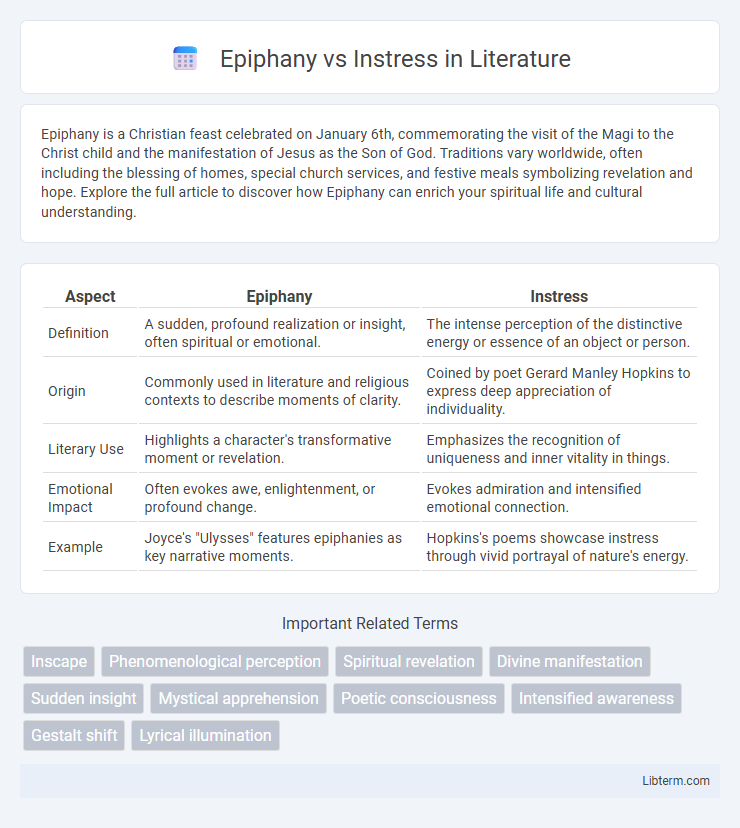Epiphany is a Christian feast celebrated on January 6th, commemorating the visit of the Magi to the Christ child and the manifestation of Jesus as the Son of God. Traditions vary worldwide, often including the blessing of homes, special church services, and festive meals symbolizing revelation and hope. Explore the full article to discover how Epiphany can enrich your spiritual life and cultural understanding.
Table of Comparison
| Aspect | Epiphany | Instress |
|---|---|---|
| Definition | A sudden, profound realization or insight, often spiritual or emotional. | The intense perception of the distinctive energy or essence of an object or person. |
| Origin | Commonly used in literature and religious contexts to describe moments of clarity. | Coined by poet Gerard Manley Hopkins to express deep appreciation of individuality. |
| Literary Use | Highlights a character's transformative moment or revelation. | Emphasizes the recognition of uniqueness and inner vitality in things. |
| Emotional Impact | Often evokes awe, enlightenment, or profound change. | Evokes admiration and intensified emotional connection. |
| Example | Joyce's "Ulysses" features epiphanies as key narrative moments. | Hopkins's poems showcase instress through vivid portrayal of nature's energy. |
Understanding Epiphany: Definition and Origins
Epiphany, derived from the Greek word "epiphaneia," means a sudden, profound realization or insight that alters perception or understanding of a concept or situation. Originating in religious contexts as a manifestation of a divine presence, its contemporary use extends to moments of clarity in literature, psychology, and everyday experiences. Unlike Instress, which emphasizes perceiving the unique energy or essence within an object or person, Epiphany centers on the transformative cognitive breakthrough itself.
The Concept of Instress: Meaning and Background
Instress, a term coined by poet Gerard Manley Hopkins, refers to the intense energy and force that enables an individual to perceive and apprehend the unique essence of a thing or moment. This concept emphasizes the internal recognition and appreciation of uniqueness, contrasting with an epiphany, which typically involves a sudden external revelation or insight. Instress highlights the dynamic process of internalizing and sustaining a connection to the intrinsic nature of an experience or object.
Historical Context: Epiphany and Instress in Literature
Epiphany in literature, popularized by James Joyce in the early 20th century, signifies a sudden, profound insight that transforms a character's understanding of their world. Instress, introduced by poet Gerard Manley Hopkins in the Victorian era, emphasizes the intense perception of an object's unique essence and individuality through empathetic emotional engagement. Both concepts reflect evolving literary efforts to capture moments of heightened awareness but focus distinctly on revelation (Epiphany) versus empathetic recognition (Instress) within their historical contexts.
Philosophical Foundations of Epiphany
Epiphany in philosophy is grounded in sudden, profound insight that reveals the true nature of reality, often linked to moments of intuitive clarity and existential awakening. Instress, by contrast, emphasizes the intensity of individual perception and the internal experience of empathy, highlighting the subjective engagement with external phenomena. The philosophical foundation of epiphany centers on transformative realizations that challenge ordinary understanding and foster deeper self-awareness.
The Role of Instress in Artistic Expression
Instress plays a crucial role in artistic expression by channeling intense, focused energy that captures the essence of a subject or moment, enabling artists to convey deep emotional and spiritual resonance. Unlike epiphany, which denotes a sudden moment of insight or revelation, instress emphasizes the sustained, dynamic engagement with the work that transforms perception into vivid creative output. This continuous process fuels originality and authenticity, making instress indispensable in realizing complex artistic visions.
Key Differences Between Epiphany and Instress
Epiphany refers to a sudden, profound realization or insight that transforms understanding, often disrupting prior thought patterns. Instress, coined by poet Gerard Manley Hopkins, describes the intense, dynamic energy or emotional charge experienced when perceiving the unique essence of an object or moment. The key difference lies in epiphany's nature as an intellectual breakthrough versus instress as the emotional force driving deep connection and perception.
Interplay of Epiphany and Instress in Creative Processes
The interplay of Epiphany and Instress drives innovation by blending sudden insight with sustained emotional engagement, fostering deeper creative breakthroughs. Epiphany delivers rapid conceptual clarity, while Instress sustains the intensity and focus required to refine and expand ideas into meaningful outcomes. Together, they enhance cognitive flexibility and artistic expression, optimizing problem-solving and imaginative depth in creative processes.
Epiphany in Modern Thought and Culture
Epiphany in modern thought and culture signifies a sudden revelation or insight that transforms understanding, often regarded as a pivotal moment in literature, philosophy, and psychology. It contrasts with Instress, which refers to the intense energy or inner experience that fuels perception and creativity rather than a singular moment of clarity. Epiphanies are central to modernist narratives, highlighting characters' internal awakenings and shifts in consciousness that challenge conventional realism.
Instress in Contemporary Art and Literature
Instress in contemporary art and literature emphasizes the intense perception of an object's unique inner nature, fostering a deep, empathetic connection between creator and audience. Unlike epiphany, which often represents a sudden moment of revelation, instress involves sustained engagement and immersion in the distinct qualities of a subject, enhancing thematic depth and emotional resonance. Modern artists and writers utilize instress to explore individual identity and existential meaning through detailed sensory experiences and nuanced emotional expressions.
Practical Applications: Embracing Epiphany and Instress
Epiphany enables sudden insights that revolutionize problem-solving and innovation, making it essential for creative industries and strategic decision-making. Instress fosters deep immersion and sustained focus, enhancing productivity and mindfulness in tasks requiring careful analysis and emotional engagement. Integrating epiphany's rapid revelation with instress's attentive presence cultivates balanced cognitive flexibility and effective practical application in diverse professional and personal contexts.
Epiphany Infographic

 libterm.com
libterm.com